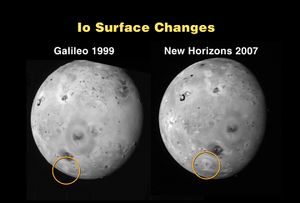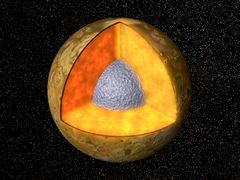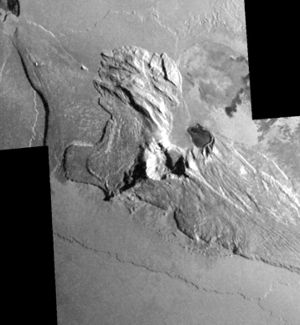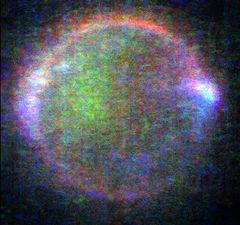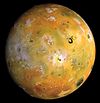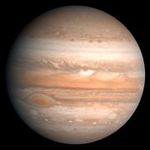إيو (قمر)
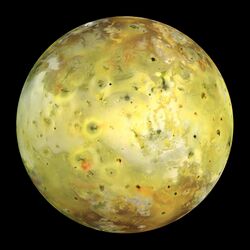 Click image for description | |||||||||
| الاكتشاف | |||||||||
|---|---|---|---|---|---|---|---|---|---|
| اكتشفه | Galileo Galilei | ||||||||
| تاريخ الاكتشاف | January 7, 1610 | ||||||||
| التسميات | |||||||||
| Jupiter I | |||||||||
| الصفات | Ionian | ||||||||
| السمات المدارية | |||||||||
| Periapsis | 420,000 km (0.002 807 AU) | ||||||||
| Apoapsis | 423,400 km (0.002 830 AU) | ||||||||
Mean orbit radius | 421,700 km (0.002 819 AU) | ||||||||
| Eccentricity | 0.0041 | ||||||||
| 1.769 137 786 d (152 853.504 7 s, 42 h) | |||||||||
Average orbital speed | 17.334 km/s | ||||||||
| Inclination | 2.21° (to the ecliptic) 0.05° (to Jupiter's equator) | ||||||||
| Satellite of | Jupiter | ||||||||
| السمات الطبيعية | |||||||||
| الأبعاد | 3,660.0 × 3,637.4 × 3,630.6 km[1] | ||||||||
نصف القطر المتوسط | 1,821.3 km (0.286 Earths)[1] | ||||||||
Mean radius | 1,821.3 km (0.286 Earths)[1] | ||||||||
| 41,910,000 km2 (0.082 Earths) | |||||||||
| Volume | 2.53×1010 km3 (0.023 Earths) | ||||||||
| Mass | 8.9319×1022 kg (0.015 Earths) | ||||||||
Mean density | 3.528 g/cm3 | ||||||||
| 1.796 m/s2 (0.183 g) | |||||||||
| 2.558 km/s | |||||||||
| synchronous | |||||||||
Equatorial rotation velocity | 271 km/h | ||||||||
| Albedo | 0.63 ± 0.02[2] | ||||||||
| |||||||||
| 5.02 (opposition)[3] | |||||||||
| Atmosphere | |||||||||
Surface pressure | trace | ||||||||
| Composition by volume | 90% sulfur dioxide | ||||||||
إيو تابع طبيعي أحد اقمار كوكب المشتري أكتشفه العالم الإيطالى المعروف گاليليو من خلال تلسكوبه البسيط سنة 1610م وهو واحد من أربعة اقمار كبيرة والمعروفة باسم أقمار گالليليو .
. . . . . . . . . . . . . . . . . . . . . . . . . . . . . . . . . . . . . . . . . . . . . . . . . . . . . . . . . . . . . . . . . . . . . . . . . . . . . . . . . . . . . . . . . . . . . . . . . . . . . . . . . . . . . . . . . . . . . . . . . . . . . . . . . . . . . . . . . . . . . . . . . . . . . . . . . . . . . . . . . . . . . . . .
الخصائص الفيزيائية
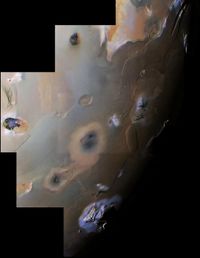
وإيو قمر شهير ومثير فهو ذو لون احمر وبرتقالى وأصفر داه براق في حالة نشاط مستمر حجمه يقارب حجمقمر الأرض فقطره يبلغ نحو 3,642 كيلو مترا وكثافته أكبر من كثافات أقمار المشتري الأخرى. (تبلغ 3,5 للسنتيمتر المكعب الواحد)
المدار
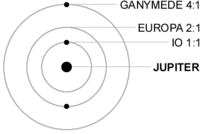
يدور إيو حول المشتري بمدار دائرى تقريبا معدل مسافته عن كوكبه الأم يبلغ نحو 3.642 كيلو مترا فهو أقرب أقمار گالليليو الأربعة الى أمه المشترى.
السمات السطحية
يتميز إيو بسطح مغطى بالكبريت وبنشاطات بركانية فريدة لانعرف لها مثيلا على الكرة الأرضية. تنطلق عالية في الفضاء فقد شاهدت المركبة الفضائية فوياجير حدوث فورانات بركانية حية مطلقة ثاني أوكسيد الكبريت الى علو نحو 300 كيلو متر في الفضاء , وشاهدت المركبة الفضائية گاليليو بعد ذلك براكين جديدة ترك بعض هذة البراكين حمما داكنة وبقعا صفراء وحمراء من الكبريت على السطح.
التكوين السطحي
عللت هذة البراكين بتاثير من قوة (المد والجزر) التى يحدثها كوكب المشتري فتعمل على إحماء قلبه وتنشيط براكينه ولهذا القمر غلاف جوى خفيف جدا.
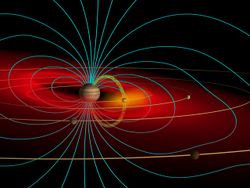
التاريخ

گالليليو
| Galileo encounters with Io | |
|---|---|
| Date | Distance (km) |
| December 7, 1995 | 897 |
| November 4, 1996 | 244,000 |
| March 29, 1998 | 252,000 |
| June 30, 1999 | 127,000 |
| October 11, 1999 | 611 |
| November 26, 1999 | 301 |
| February 22, 2000 | 198 |
| August 6, 2001 | 194 |
| October 16, 2001 | 184 |
| January 17, 2002 | 102 |
| November 7, 2002 | 45,800 |
الداخلية
البراكين
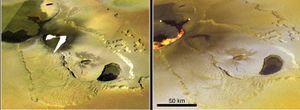
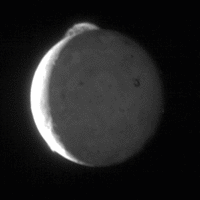
. . . . . . . . . . . . . . . . . . . . . . . . . . . . . . . . . . . . . . . . . . . . . . . . . . . . . . . . . . . . . . . . . . . . . . . . . . . . . . . . . . . . . . . . . . . . . . . . . . . . . . . . . . . . . . . . . . . . . . . . . . . . . . . . . . . . . . . . . . . . . . . . . . . . . . . . . . . . . . . . . . . . . . . .
الجبال
انظر ايضا
المصادر
- مؤمن, عبد الأمير (2006). قاموس دار العلم الفلكي. بيروت، لبنان: دار العلم للملايين.
{{cite book}}: Cite has empty unknown parameter:|طبعة أولى coauthors=(help)
- ^ أ ب
Thomas, P. C. (1998). "The Shape of Io from Galileo Limb Measurements". Icarus. 135 (1): 175–180. doi:10.1006/icar.1998.5987.
{{cite journal}}: Unknown parameter|coauthors=ignored (|author=suggested) (help) - ^ Yeomans, Donald K. (July 13, 2006). "Planetary Satellite Physical Parameters". JPL Solar System Dynamics. Retrieved 2007-11-05.
- ^ "Classic Satellites of the Solar System". Observatorio ARVAL. Retrieved 2007-09-28.
- ^ Spencer, J. "John Spencer's Astronomical Visualizations". Retrieved 2007-05-25.
{{cite web}}: Cite has empty unknown parameters:|month=and|coauthors=(help)
وصلات خارجية
- General information
- Io Profile by NASA's Solar System Exploration
- Bill Arnett's Io webpage
- Io overview from the University of Michigan's Windows to the Universe
- Calvin Hamilton's Io page
- The Planetary Society: Io information
- Images
- Additional References


